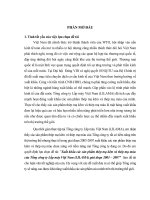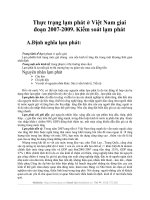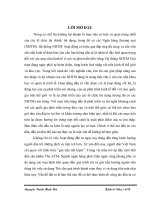AFNY 24 april 2007
Bạn đang xem bản rút gọn của tài liệu. Xem và tải ngay bản đầy đủ của tài liệu tại đây (1.56 MB, 41 trang )
Carbon
Taxes First
Charles Komanoff
& Dan Rosenblum
Carbon Tax Center
www.carbontax.org
April 24, 2007
Global Warming Is …
Triggering a climate crisis that threatens
massive and irreversible damage to our
global environment, public health, world
peace, national security and economic wellbeing.
No longer seriously contested by anybody
other than vested interests, their hired
“experts” and indebted politicians.
See An Inconvenient Truth and IPCC Fourth
Assessment.
Warmer Winters: 4.3ºF, 1971-2002
Boston is the new
Philly; NYC is the
new D.C. (winter
temps.)
43
Boston
o
Latitude ( N)
42
New York
41
Philadelphia
40
Washington, DC
39
38
29
30
31
32
33
34
35
o
Winter (Dec-Jan-Feb) Mean Temp (ºF)
36
37
Cameron
More Extreme Weather
Extreme Precipitation Events,
% Increase 1949-2002
Cameron Wake, UNH
The Problem:
Unsustainable CO2
Emissions Worldwide
World must reduce emissions ~80% by
2050, with big cuts starting now.
Americans are emitting many times our
share of CO2 (next slide).
Americans must reduce by >80%.
Americans Emit in a Day
What Others Emit in a Workweek
What about China?
“In an alliance of
denial, China and
the United States
are using each
other’s inaction as
an excuse to do
nothing.” – New
York Times
editorial, 4-20-07
China
X
U.S.
Chemistry → Responsibility
Because CO2 stays
“resident” in the
atmosphere for at
least a century, one
hundred years of
fossil-fuel use drive
climate responsibility. U.S. still has
a 40-50-year lead.
X
U.S.
China
No More Free Dumping
“Since the dawn of the industrial revolution,
the atmosphere has served as a free dumping
ground for carbon gases. If people and
industries are made to pay heavily for the
privilege, they will inevitably be driven to
develop cleaner fuels, cars and factories.”
— Avoiding Calamity on the Cheap, Nov. 3, 2006
New York Times editorial
Putting a Price on CO2 Emissions
High taxes on carbon emissions from
coal, oil and natural gas will:
Reduce fossil fuel use and CO2 emissions
Substitution of clean fuels and technology
More efficient use of energy
Provide a revenue stream to enable
Progressive tax-shifting, or
Rebate to all U.S. residents
Additional Benefits
of a Carbon Tax
Carbon tax receipts may also be used to finance
Energy efficiency, further reducing use of fossil
fuels and related emissions.
Energy R&D.
Will also reduce dependence on foreign oil,
with major national security benefits.
Economically, will keep dollars in USA instead
of flowing overseas.
Rely on “Market Forces”?
Here Come Synfuels
Only a carbon
tax can subject
CO2-intensive
oil sands,
oil shale,
coal-into-oil, etc.
to a climateappropriate
market test.
Clean-Energy Subsidies:
A Limited Answer
Selecting the next best energy technology by
fiat has largely benefited lobbyists + special
interests
Oil shale, nuclear power, synfuels, ethanol, etc.
Many new sources also emit CO2
Renewable Portfolio Standards: helpful – but
not enough
Efficiency Standards:
Vital, but Not Enough
Too slow
Corporate gaming
Corporate resistance
Inherently reactive
(e.g., “CAFE” loophole that enabled SUV’s)
Scattershot – impossible to regulate the
hundreds of important energy-usage sectors
1-dimensional
(e.g., CAFE doesn’t affect miles driven)
More than Half of U.S. Oil Use
Is Not Gasoline for Cars
Freight
Heat, Power
Other
Cars
Air
RV’s Paving
Example - Gas Use Decisions
CAFE impacts:
Mfg’er mpg decisions
What car to buy
Gas Tax-Shift
impacts:
How high CAFE is set
Mfg’er mpg decisions
What car to buy
Which car to drive
How to drive
VMT (miles traveled)
Share (carpool)
Chain trips
Transit
Walk/Bike
Proximity
Dynamic Capitalism & CO2: I
“ … specially equipped,
privately owned jumbo
jets – the kind that
normally carry 300-400
passengers … reconfigured … for the
enjoyment of, at most,
a couple of dozen.”
New York Times, 17-Oct-2006: For the SuperRich, It’s Time to Upgrade the Old Jumbo Jet
Dynamic Capitalism & CO2: II
Backyard Blizzards:
“Snowmaking, since the
mid-1960s the provenance
of ski resorts and, more
recently, some party
planners, has gone
domestic,” with 2-kW
plug-in snowmakers that
run ’round-the-clock.
New York Times (Home Section) 15-Feb-2007:
Not Enough Snow For You? Talk to Your Father
Example - Electricity
Utilities and other generators will
Respond to price signal by substituting
lower-carbon fuels
Renewables
Natural Gas
Invest in efficiency on demand- and
supply-side
Consumers will
Respond by using less
Substituting low- or non-carbon energy
Carbon Tax Proportions
Fuels are
taxed by
their
carbon
content
per btu
A “Starter” Carbon Tax-Shift
$37 / ton of carbon =
10¢ / gallon of gasoline, jet fuel, etc. =
0.72 ¢ / kWh (U.S. retail average)
Reduces U.S. CO2 emissions ~ 4%
Repeat 10 X (while standards and incentives
also cut emissions)
Energy Use: Not Inelastic
Gasoline usage grew only 3.5% from 2003 to
2006, while the economy grew 11%.
Pump prices have risen < 50% since 2003
(adjusted for inflation) – not the doubling
commonly believed.
The modest growth in demand points to a “shortterm price elasticity” of around 0.1, and 0.4 in the
long term.
Finding: Demand for gasoline (and other fuels) is
at least somewhat price-sensitive.
Elasticity (long-run) Assumptions
Gasoline: - 0.4
Electricity
Residential (37%) - 0.5
Commercial / Industrial
(63%) - 1.0
Fuel-switching
Leverage: 1.2 x
“Other” – midway
bet. Gasoline/Elect.
U.S. CO2
Reductions
Starter Tax – Why Ramp Up?
Win broad consensus
Implement ASAP
Help people and businesses adapt
Empirical validation of efficacy
Mid-course corrections
Establish long-term price trajectory
Complement w/ investment in EE and renewables
USA After “Starter Tax x 10”
CO2 emissions down by a third
Oil use down by ~5 million barrels/day
Energy
Coal-fired generation reduced
Wind and other renewable generation increased
Incandescents / halogens out, CFL’s + LED’s in
Transportation and Land-Use
SUVs out, sedans in
Costlier air and highway travel creates market
pull for 300-mph intercity rail
Urban trips by bicycle up 10x, to 10%
Urban revitalization









